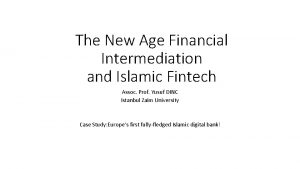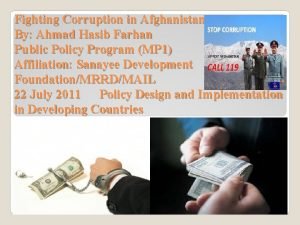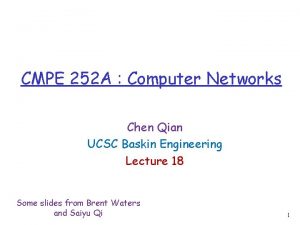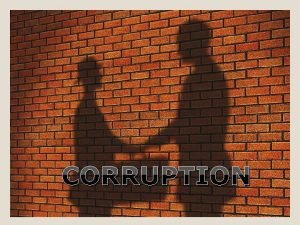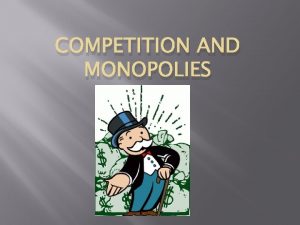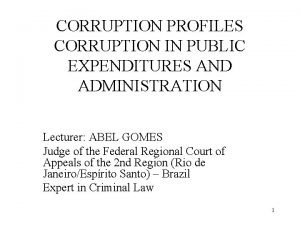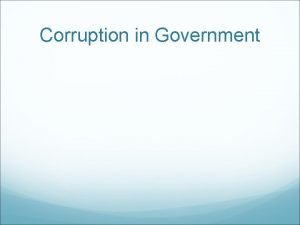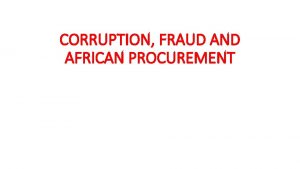Allen Qian PacificSymposium06 Corruption and Competition Franklin Allen













- Slides: 13

Allen & Qian Pacific-Symposium-06 Corruption and Competition Franklin Allen Wharton School Jun “QJ” Qian Carroll School of Management University of Pennsylvania Boston College Symposium on “Rethinking Corruption” Mc. George School of Law, University of the Pacific October 27, 2006 Updated version of the paper can be downloaded at: http: //www 2. bc. edu/~qianju/research. html 1

Allen & Qian Pacific-Symposium-06 Motivation • Damaging effects of corruption: – Distortion of incentives and misallocation of resources; – At its worst, corruption is theft and robbery committed by high-rank government officials; – Ample evidence on the damaging effects at micro-levels; – It is also a pervasive and persistent problem • Corruption and economic growth: – How to measure corruption: Indexes produced by international agencies based on surveys (e. g. , Transparency International); – Is the elimination of corruption a necessary condition for economic growth in developing countries? • Paul Wolfowitz (President of the World Bank) vs. Hilary Benn 2

Allen & Qian Pacific-Symposium-06 Motivation (cont’d) (Svensson 2005, JEP) 3

Allen & Qian Pacific-Symposium-06 Motivation (cont’d) 4

Allen & Qian Pacific-Symposium-06 Motivation (cont’d) 5

Allen & Qian Pacific-Symposium-06 Motivation (cont’d) • In large and regionally diversified countries: – Such as China and India, corruption has not slowed down economic growth (Allen, Qian and Qian 2005; Allen et al. 2006) • In many African and South American countries: – Corrupt officials seem to have severely retarded growth • What about Russia? – Composition of industries 6

Allen & Qian Pacific-Symposium-06 Research Goals • Re-examine the reasons for the occurrence of corruption: – Linking corruption with government’s ability to raise tax revenues; • Develop a new rationale: – To explain the different impact of corruption on growth across countries; • Provide new empirical predictions: – Impact of corruption on different countries/regions; – Impact of corruption on different industries and firms; – Impact of corruption and the degrees of competition among officials; • Policy implications: – How to set up the provision of government goods and services; – How to link the efforts to control corruption with other types of regulations; – How to measure the performance of local government officials. 7

Allen & Qian Pacific-Symposium-06 Related Work • Literature on “efficient” corruption: – Leff (1964) and Huntington (1968); – Competition among economic agents (e. g. , Lui 1985; Bliss and Di Tella 1997; Ades and Di Tella 1999) • Shleifer and Vishny (1993) • Literature on central vs. local government officials: – Principal-agent relationship first developed by Becker and Stigler (1974); – How to motivate agents to implement socially optimal goals • Literature on institutions and economic growth: – Rajan and Zingales (2003 a, b); – Acemoglu and Johnson (2005) • Empirical literature on corruption: – Corruption and economic growth (e. g. , Mauro 1995; Svensson 2005); – Corruption and provision of government goods and services (micro). 8

Allen & Qian Pacific-Symposium-06 Main Results • In our model corruption occurs when: – Government cannot raise sufficient tax revenues to finance the (costly) provision of goods and services; • Long-run solution is to increase government’s taxing ability; • In the short-run, bribes can be regarded as user fees • Impact of corruption on economic growth depends on: – Degree of competition among officials providing the same good/service • Perfect (Bertrand) competition: User fees are competitively determined and damaging effects of corruption are minimized; • Monopoly: Much higher user fees => provision of goods and services below socially optimal level; • Imperfect (Bertrand) competition: Relocation costs of agents affect the quantity of goods and services provided. 9

Allen & Qian Pacific-Symposium-06 Empirical Predictions • Corruption and government’s taxing ability • Corruption and the degree of competition in the provision of government goods and services: – Negative impact of corruption depends on regional competition: • Large and diverse countries (e. g. , China and India); • Small and homogeneous countries (African and South American countries) – Negative impact of corruption also depends on firm and industry characteristics: • Relocation costs are lower for small firms and industries require less (immovable) fixed assets; • Empirical literature on the size of “Underground economy” • China/India vs. Russia 10

Allen & Qian Pacific-Symposium-06 Policy Implications • Eliminating corruption during early stage of development: – Unlikely to be effective; – Long-term solution is to increase government’s taxing ability • How to limit the negative impact of corruption: – Set up provision of goods and services in a competitive environment: • This can be implemented even in small and homogeneous countries; – Encourage regional competition: • Inter-regional trade (Imports/exports over GDP; Svensson 2005); • Lower regulation of entry and costs of relocation (Djankov et al. 2002) – Evaluating performance of government officials: • Performance measures based on economic growth and amount of activities from nonlocal sources (see Li (1998) for example on China). 11

Allen & Qian Pacific-Symposium-06 Ongoing and Future Work • Model extensions: – Costs of providing the good/service: • • Different across officials; Fixed and variable costs; Asymmetric information in cost structure Literature on defense procurement; – Different types of government goods and services: Externality • More empirical evidence on corruption, finance and growth – Law, institutions, finance and growth in Africa • Direct empirical tests of the model 12

Allen & Qian Pacific-Symposium-06 Summary • Despite evidence of the damaging effects of corruption at the micro-level, there is no significant relation between corruption and growth at the aggregate level; • We argue that the degree of competition in the provision of government goods/services can explain cross-country differences of corruption’s impact on growth; • More effective way to control corruption and promote growth would be to increase competition among officials rather than punishing corrupt officials. 13
 Franklin allen imperial
Franklin allen imperial Wanderers nachtlied
Wanderers nachtlied Monopoly vs perfect competition
Monopoly vs perfect competition Monopoly vs monopolistic competition
Monopoly vs monopolistic competition Monopoly vs oligopoly venn diagram
Monopoly vs oligopoly venn diagram Perfect competition vs monopolistic competition
Perfect competition vs monopolistic competition Fraud and corruption analaytics
Fraud and corruption analaytics Uk bribery act training slides
Uk bribery act training slides Conclusion for corruption
Conclusion for corruption Chuang qian ming yue guang li bai
Chuang qian ming yue guang li bai Hen duo qian
Hen duo qian Steve qian
Steve qian Abe
Abe Xiaomin qian purdue
Xiaomin qian purdue
